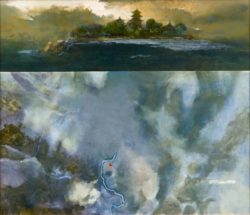Gaither Troutman Pope
Painter Gaither Troutman Pope is best known for his landscapes of Louisiana's prairies and dark swamps influenced by nineteenth-century Luminist painters.

Courtesy of Gaither Pope
Theme Park Closed. Pope, Gaither (artist)
Gaither Troutman Pope’s contemporary paintings of the Louisiana landscape do not employ the characteristic realism commonly found in works by Victorian painters. Instead, his depictions of watery prairies and dark swamps are intuitive and as devoted to light as those of nineteenth-century Luminist painters.
Born on July 27, 1953, in Jackson, Mississippi, Pope resides in Baton Rouge and teaches drawing and painting at Nicholls State University in Thibodaux. “As Baton Rouge is to Louisiana, Jackson is the pivotal line between northern and southern Mississippi,” Pope wrote in 2011. “In all of my years in Mississippi, I was always attracted to the southern part of the state, especially the coastal region with its salt marshes and swamps, its barrier islands, and bay area, so remote in comparison to other coastal areas in the Southeast U.S. where tourists flock to each year. As a young man, while in the employ of an architectural/engineering firm in Jackson, I spent much time on a survey crew in the Waveland and Bay St. Louis area of the coast and it was at this time that I became fully entrenched in the magic of the region. By ‘magic,’ I truly mean a sort of mystical energy that exists in this region that is, for me, very palatable. It has been this sense of mystery that has drawn me ever more south throughout my adult life. When I began living in Baton Rouge as a graduate student at LSU in the early ‘90s, I knew then that I would be very reluctant to leave after grad school. I never did leave.”
With degrees in art from Tougaloo College in Jackson and a master of fine arts from Louisiana State University, where he studied under Robert Warrens, Michael Crespo, Melody Guichet, Robert Hausey, Christopher Johns, and Edward Pramuk, Pope says the artists who had the most influence on his work were the nineteenth-century American painters known as the Luminists, and others later in the century such as Ralph Blakelock and George Inness. “The appeal of these artists to me is not formal alone,” he once wrote, “nor is their subject matter exclusively what draws me to them; there is also a sense of a sort of spiritual connection to them. They worked in relative isolation and they used the elements of their respective terrain to impart the emotive qualities symbolized by the land. While I don’t (and can’t) attempt to effect the temperament of a nineteenth century painter in my work, I still believe their approach to the landscape has validity in our time, especially here in Louisiana where so much of our collective perspective on the world is keyed to our relationship with the land.”
Pope describes his paintings as “grounded in landscape and landscape elements, flora and fauna.” He explained, “I try to use the land in a way that is not entirely narrative, yet does suggest narrative, metaphor, and, occasionally, allegory. While I am versed in the symbols used by my nineteenth-century American predecessors, I know these are lost upon a contemporary audience. However, I am not averse to creating my own personal symbols, minus any universally understood meanings. Again, I may make suggestions, but not pronouncements, through my work.”
Pope loves to play with space by dividing the canvas into sections. Each section may or may not include imagery that relates to the other. These divided canvases are like pages in a book or magazine and date back to his days working as a printer in Mississippi. Yet unlike the progressive storyline in a book or magazine article, Pope says he “never tries to tell stories.” Images in his paintings, such as birds and a piano, are recognizable but are not set into a narrative. These images are often drawn from memory of things that he has seen or places he has been.
At times, Pope does small preliminary drawings or takes photographs as field notes for later use in the studio, but he does not paint directly from those studies or photographs. They are starting points for whatever rises in his imagination as he paints. When he doesn’t do preliminary drawings, he goes directly to the painting surface, usually a wood panel, and paints in shapes, lines, and zones. The painting evolves slowly as he adds imagery. “
Pope’s paintings are in the collections of several private and corporate collectors, including famed New Orleans jewelry designer Mignon Faget; Butler and Snow, Attorneys at Law, in Gulfport, Mississippi; New Orleans law firms McGlinchey, Stafford; Plauche, Masselli, and Parkerson; Taylor, Wellons, Politz, and Duhe; and Iberia Bank in New Iberia, Louisiana.
In 1996 Pope’s paintings were included in the New Orleans Contemporary Arts Center’s twentieth anniversary show. That same year, his work took first place in a statewide competition at the Louisiana Arts and Science Center’s Project Harmony.
